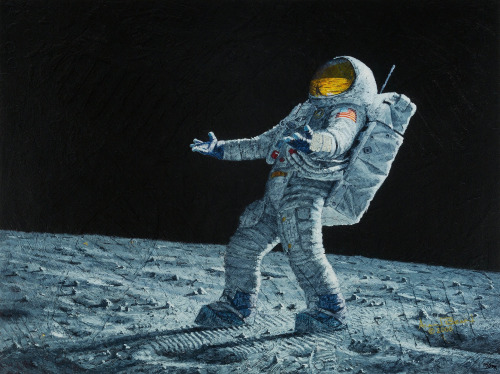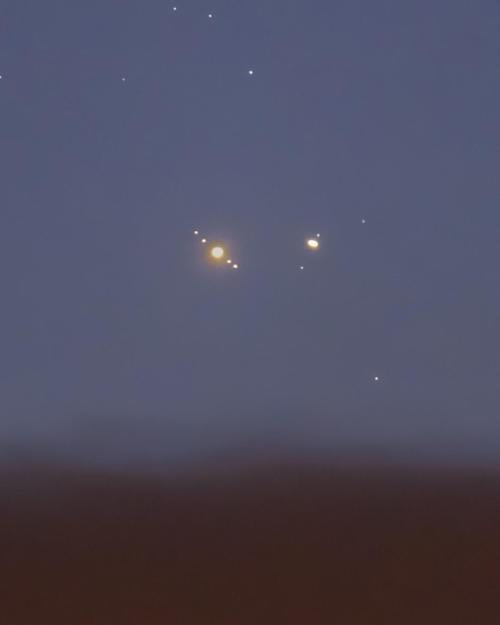“Is Anyone Out There?” Self-portrait By Apollo 12 Astronaut Alan Bean, 2000.

“Is Anyone Out There?” Self-portrait by Apollo 12 astronaut Alan Bean, 2000.
More Posts from Epic-flight and Others







Artworks by Lucio Perinotto
1936-1945 | Boeing B-17 Flying Fortress
1953-1959 | North American F-100 Super Sabre
1936-1942 | Latécoère Laté 298
1941-1945 | Hawker Typhoon
1934-1936 | Caudron C.460 Racer
1938-1948 | Supermarine Spitfire
1936-1945 | Boeing B-17 Flying Fortress

Comet NEAT revealed in close-up by the WIYN 0.9-meter telescope at Kitt Peak National Observatory near Tucson, Arizona on May 7, 2004.
(HubbleSite)


A Colorful Moon The Moon is normally seen in subtle shades of grey or yellow. But small, measurable color differences have been greatly exaggerated to make this telescopic, multicolored, moonscape captured during the Moon’s full phase. The different colors are recognized to correspond to real differences in the chemical makeup of the lunar surface. Blue hues reveal titanium rich areas while orange and purple colors show regions relatively poor in titanium and iron. The familiar Sea of Tranquility, or Mare Tranquillitatis, is the blue area in the upper right corner of the frame. White lines radiate across the orange-hued southern lunar highlands from 85 kilometer wide ray crater Tycho at bottom left. Above it, darker rays from crater Copernicus extend into the Sea of Rains (Mare Imbrium) at the upper left. Calibrated by rock samples from the Apollo missions, similar multicolor images from spacecraft have been used to explore the Moon’s global surface composition. Image Credit & Copyright: László Francsics

A 1979 work by space artist Don Dixon shows dwarf planet Pluto as seen from one of its moons. (Cosmographica)


‘antipode’

Conjunction: Jupiter and Saturn
Credit: Vladimir Mach



David A. Hardy









“I would like to humanize the space age by giving a perspective from a non-astronaut, because I think the students will look at that and say, ‘This is an ordinary person. This ordinary person is contributing to history.’”
—Christa McAuliffe (September 2, 1948–January 28, 1986)
-
 musics-georg reblogged this · 2 weeks ago
musics-georg reblogged this · 2 weeks ago -
 myboredjunk reblogged this · 2 weeks ago
myboredjunk reblogged this · 2 weeks ago -
 flameless-pira liked this · 2 weeks ago
flameless-pira liked this · 2 weeks ago -
 qualityblizzardcreation reblogged this · 2 weeks ago
qualityblizzardcreation reblogged this · 2 weeks ago -
 gheycowboyespressokell liked this · 2 weeks ago
gheycowboyespressokell liked this · 2 weeks ago -
 shadowsviking liked this · 2 weeks ago
shadowsviking liked this · 2 weeks ago -
 ariyous-dusk-mod reblogged this · 2 weeks ago
ariyous-dusk-mod reblogged this · 2 weeks ago -
 ariyous-dusk-mod liked this · 2 weeks ago
ariyous-dusk-mod liked this · 2 weeks ago -
 elgringo300 reblogged this · 3 weeks ago
elgringo300 reblogged this · 3 weeks ago -
 trideltai liked this · 3 weeks ago
trideltai liked this · 3 weeks ago -
 friar-fryer reblogged this · 3 weeks ago
friar-fryer reblogged this · 3 weeks ago -
 not-a-robot-technically reblogged this · 3 weeks ago
not-a-robot-technically reblogged this · 3 weeks ago -
 number1-best-friend-naim liked this · 3 weeks ago
number1-best-friend-naim liked this · 3 weeks ago -
 mx-yip-yip-hooary reblogged this · 3 weeks ago
mx-yip-yip-hooary reblogged this · 3 weeks ago -
 thedrugdude liked this · 3 weeks ago
thedrugdude liked this · 3 weeks ago -
 spideeroo liked this · 3 weeks ago
spideeroo liked this · 3 weeks ago -
 i-am-phroggie liked this · 3 weeks ago
i-am-phroggie liked this · 3 weeks ago -
 stuck-in-limbo-with-a-lost-soul reblogged this · 3 weeks ago
stuck-in-limbo-with-a-lost-soul reblogged this · 3 weeks ago -
 stuck-in-limbo-with-a-lost-soul liked this · 3 weeks ago
stuck-in-limbo-with-a-lost-soul liked this · 3 weeks ago -
 katcos-bean-collection reblogged this · 3 weeks ago
katcos-bean-collection reblogged this · 3 weeks ago -
 song-of-sorens reblogged this · 3 weeks ago
song-of-sorens reblogged this · 3 weeks ago -
 squigglyexplosive reblogged this · 3 weeks ago
squigglyexplosive reblogged this · 3 weeks ago -
 squigglyexplosive liked this · 3 weeks ago
squigglyexplosive liked this · 3 weeks ago -
 iloveyoufarewell reblogged this · 3 weeks ago
iloveyoufarewell reblogged this · 3 weeks ago -
 jinbark0u reblogged this · 3 weeks ago
jinbark0u reblogged this · 3 weeks ago -
 theasianinfluence reblogged this · 3 weeks ago
theasianinfluence reblogged this · 3 weeks ago -
 invenblocker reblogged this · 3 weeks ago
invenblocker reblogged this · 3 weeks ago -
 kunaiman reblogged this · 3 weeks ago
kunaiman reblogged this · 3 weeks ago -
 choatic-bumblebee-agenda reblogged this · 3 weeks ago
choatic-bumblebee-agenda reblogged this · 3 weeks ago -
 tiesiog-kajus liked this · 3 weeks ago
tiesiog-kajus liked this · 3 weeks ago -
 idk-the-foolish-immortal liked this · 3 weeks ago
idk-the-foolish-immortal liked this · 3 weeks ago -
 starboundsingularities liked this · 3 weeks ago
starboundsingularities liked this · 3 weeks ago -
 6purplescissors reblogged this · 3 weeks ago
6purplescissors reblogged this · 3 weeks ago -
 zorromanzana liked this · 3 weeks ago
zorromanzana liked this · 3 weeks ago -
 that-one-guy-nobody-remembers liked this · 3 weeks ago
that-one-guy-nobody-remembers liked this · 3 weeks ago -
 tatertotvk9 reblogged this · 3 weeks ago
tatertotvk9 reblogged this · 3 weeks ago -
 burricane reblogged this · 3 weeks ago
burricane reblogged this · 3 weeks ago -
 burricane liked this · 3 weeks ago
burricane liked this · 3 weeks ago -
 phoub liked this · 3 weeks ago
phoub liked this · 3 weeks ago -
 lwh123 reblogged this · 3 weeks ago
lwh123 reblogged this · 3 weeks ago -
 quantim reblogged this · 3 weeks ago
quantim reblogged this · 3 weeks ago -
 kittykatgaymer liked this · 3 weeks ago
kittykatgaymer liked this · 3 weeks ago -
 haha-you-said-traps reblogged this · 3 weeks ago
haha-you-said-traps reblogged this · 3 weeks ago -
 thatguywhodoesstuff reblogged this · 3 weeks ago
thatguywhodoesstuff reblogged this · 3 weeks ago -
 ironvitriol reblogged this · 3 weeks ago
ironvitriol reblogged this · 3 weeks ago
